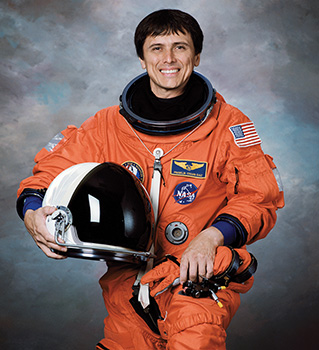Chang-Díaz, Franklin (1950-…), a United States astronaut, became the first Hispanic American to travel in space. On Jan. 12, 1986, Chang-Díaz began a six-day flight on the space shuttle Columbia. The other members of the crew were astronauts Charles F. Bolden, Jr., Robert J. Cenker, Robert L. Gibson, Steven A. Hawley, George D. Nelson, and Congressman Bill Nelson of Florida. During the mission, Chang-Díaz helped release a telecommunications satellite and participated in astrophysics experiments. He has since flown in five other space missions. Few other astronauts have completed as many missions.

In October 1989, Chang-Díaz made his second shuttle flight. On this mission, the astronauts aboard space shuttle Atlantis launched the Galileo space probe to explore Jupiter.
Chang-Díaz began an eight-day mission on the space shuttle Atlantis on July 31, 1992. He and the Atlantis crew released a European Space Agency research satellite called EURECA (_Eu_ropean _Re_trievable _Ca_rrier) into orbit. EURECA carried a number of automated experiments designed to take place in nearly weightless conditions.
Chang-Díaz made his fourth shuttle flight in February 1994. The crew included Sergei K. Krikalev, the first Russian cosmonaut to fly aboard a U.S. spacecraft. The crew tested the Wake Shield Facility, a satellite designed to grow semiconductor crystals in space.
From Feb. 22 to March 9, 1996, Chang-Díaz flew his fifth shuttle flight. The Columbia crew deployed the Tethered Satellite System (TSS), developed jointly by the Italian Space Agency and NASA. The TSS consisted of a satellite attached to the shuttle by a very long, thin cable. The system generated up to 3,500 volts as it moved through the ionosphere (electrically charged layer of Earth’s atmosphere).
The astronaut’s sixth mission began on June 2, 1998. The space shuttle Discovery flew the last of nine U.S. shuttle missions to the Soviet space station Mir.
Chang-Díaz was born in San José, Costa Rica. Ever since he was a young child, he knew he wanted to become an astronaut. In 1968, he moved to the United States to follow his dream. Chang-Díaz lived with relatives in Hartford, Connecticut. In 1973, he received a bachelor’s degree in mechanical engineering from the University of Connecticut. Chang-Díaz earned a doctor’s degree in applied plasma physics from Massachusetts Institute of Technology (MIT) in 1977, the same year he became a U.S. citizen.
Chang-Díaz joined the astronaut program in 1980. From 1993 to 2005, he was director of the Advanced Space Propulsion Laboratory at the Johnson Space Center in Houston. He then retired from NASA and started his own rocket engine company. The company is working with NASA in designing a rocket propulsion system that could be used to send a spacecraft and crew to Mars.
